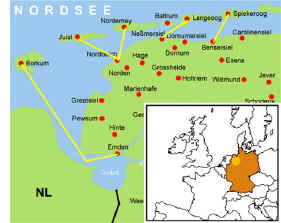Frisia (West Frisian: Fryslân; North Frisian: Fraschlönj, Freesklöön, Freeskluin, Fresklun, and Friislön'; Saterfrisian (East Frisian): Fräislound; East Frisian Low Saxon: Freesland; Gronings: Fraislaand; German and Dutch: Friesland; Danish: Frisland) is a coastal region along the southeastern corner of the North Sea, i.e. the German Bight. Frisia is the traditional homeland of the Frisians, a Germanic people who speak Frisian, a language closely related to the English language. Frisia extends from the northwestern Netherlands across northwestern Germany and into a little part of southwestern Denmark (to the river Vidå).
Divisions
Frisia changed dramatically throughout time, both by floods and by a change in identity.
History
The Frisians had settled in Frisia from about 500 BC. According to Pliny the Younger, in Roman times, the Frisians (or, as it may be, their close neighbours, the Chauci) lived on terps, man-made islands. According to other sources, the Frisians lived along a broader expanse of the coast of the North Sea (or "Frisian Sea").
Frisia at this time comprised the present provinces of Friesland and North Holland. A large part of the population of the present Netherlands lived in present Friesland, because of the fertile grounds there.
Kingdom of Frisia
Frisians made polders in West Friesland, which moved further and further away from Friesland due to floods. The western part of Frisia became the county of Holland in 1101 after a few centuries of a different history than the other parts. Frisia began to identify itself as a country with free folk in the Middle Ages. The bishopric of Utrecht did not belong to this Frisia anymore. There were many floods in the 11th and 12th centuries, which led to the deaths of many, and the forming of the Zuiderzee. The largest flood was in 1322.
Loss of territory
The free Frisians (actually petty noblemen) and the city of Groningen founded the Opstalboom League to counter feudalism. It consisted of modern Friesland, Groningen, East Frisia and the German North Sea coast and parts of the Danish North Sea coast. But the Opstalboom league did not only consist of Frisians. The area Zevenwouden was Saxon and the city of Groningen as well. Some Frisians lived under the rule of the counts of Holland in West Friesland. The Opstalboom League was not a success. It collapsed after a few years because of continuous internal strife.
Opstalboom League
The 15th century saw the end of the free Frisians. The city of Groningen started to dominate Groningen. A petty nobleman in East Frisia managed to defeat the other petty noblemen and became count of East Frisia. The archbishop of Bremen-Hamburg and the king of Denmark conquered large areas of Frisia. Only Friesland remained for the Frisian Freedom. Friesland was conquered in the 1490s by duke Albert of Saxony-Meissen.
 Frisian territories
Frisian territoriesAlthough the Frisian regions have their own separate flags, Frisia did not have a flag of its own until September 2006. The flag for united Frisia was made by the group of Auwerk, which supports a united Frisia as an official country.
As you can see, the flag has been inspired by the Scandinavic cross, like in the Norse and Icelandic flag. The four pompeblêden refer to the seven pompeblêden on the West-Frisian flag, but the amount of four means the four separated frisian regions.
